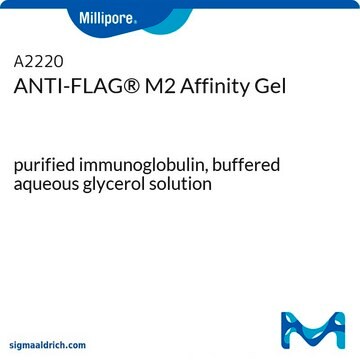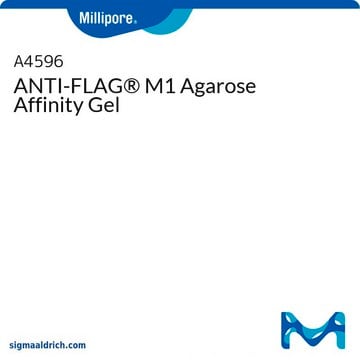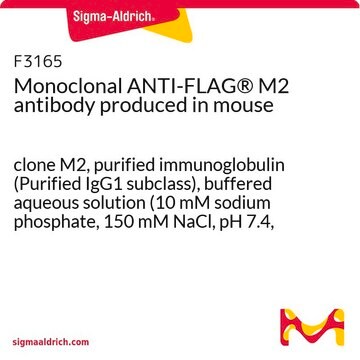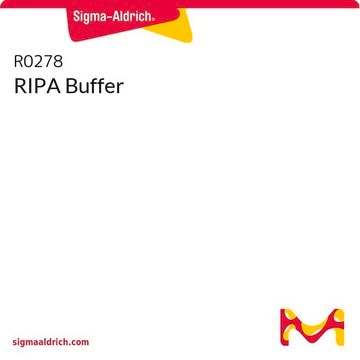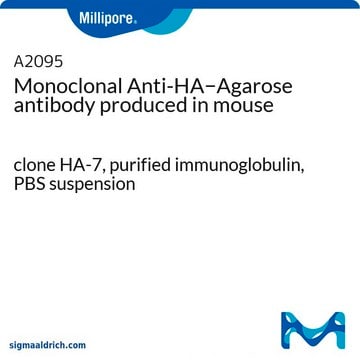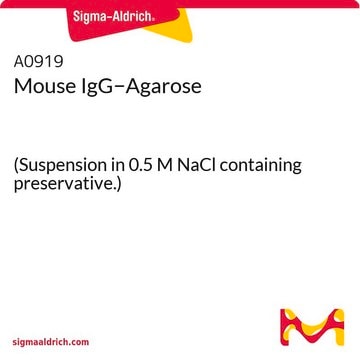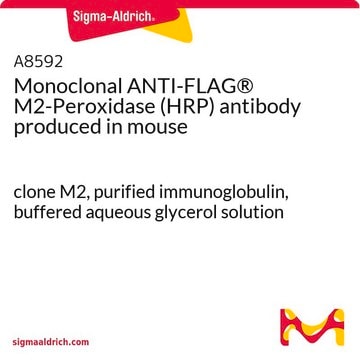The binding capacity of the resin must be ? 0.6 mg/mL to meet specifications. This capacity will vary from lot to lot.
F2426
Gel d'affinité ANTI-FLAG® M2 EZview™ Rouge
clone M2
Synonyme(s) :
Anticorps monoclonal ANTI-FLAG® M2 antibody produced in mouse, Anti-ddddk, Anti-dykddddk
Sélectionner une taille de conditionnement
818,00 €
Sélectionner une taille de conditionnement
About This Item
affinity chromatography
immunoprecipitation (IP): suitable
818,00 €
Produits recommandés
Clone
M2, monoclonal
Niveau de qualité
Classe(s) chimique(s) de l'analyte
proteins
Technique(s)
affinity chromatography: suitable
immunoprecipitation (IP): suitable
Matrice
4% agarose bead; 45-165μm bead size
Isotype
IgG1
Capacité
≥0.6 mg/mL, gel binding capacity
Conditions d'expédition
wet ice
Température de stockage
−20°C
Vous recherchez des produits similaires ? Visite Guide de comparaison des produits
Description générale
Spécificité
Application
Élution - peptide FLAG, glycine, pH 3,5, peptide 3xFLAG.
Pour en savoir plus sur nos produits, rendez-vous sur notre portail des applications des produits FLAG®.
Forme physique
Informations légales
Clause de non-responsabilité
Produit(s) apparenté(s)
Code de la classe de stockage
10 - Combustible liquids
Classe de danger pour l'eau (WGK)
WGK 3
Point d'éclair (°F)
Not applicable
Point d'éclair (°C)
Not applicable
Faites votre choix parmi les versions les plus récentes :
Certificats d'analyse (COA)
Vous ne trouvez pas la bonne version ?
Si vous avez besoin d'une version particulière, vous pouvez rechercher un certificat spécifique par le numéro de lot.
Déjà en possession de ce produit ?
Retrouvez la documentation relative aux produits que vous avez récemment achetés dans la Bibliothèque de documents.
Les clients ont également consulté
Protocoles
Protocol for immunoprecipitation (IP) of FLAG fusion proteins using M2 monoclonal antibody 4% agarose affinity gels
Contenu apparenté
Techniques, réactifs et protocoles permettant de purifier les protéines recombinantes par différentes méthodes telles que la chromatographie d'échange d'ions, la chromatographie d'exclusion stérique ou la chromatographie d'affinité.
Protein purification techniques, reagents, and protocols for purifying recombinant proteins using methods including, ion-exchange, size-exclusion, and protein affinity chromatography.
Technologies d'expression protéique permettant d'exprimer des protéines recombinantes dans des systèmes d'expression de type E. coli, cellules d'insectes, levures et cellules de mammifères pour la recherche fondamentale et pour faciliter la production de médicaments et de vaccins.
Protein expression technologies for various expression systems supporting research, therapeutics, and vaccine production.
-
What is the binding capacity of the Product F2426, EZview™ Red ANTI-FLAG® M2 Affinity Gel clone M2, resin?
1 answer-
Helpful?
-
-
When using Product F2426, EZview™ Red ANTI-FLAG® M2 Affinity Gel clone M2, should I use a 3X FLAG peptide or a 1X FLAG peptide to elute my protein?
1 answer-
If you have a 3X FLAG-tagged protein, then you will need to use the 3X FLAG peptide. If you have a 1X FLAG-tagged protein, you can use the 1X FLAG peptide or the 3X FLAG peptide. We have not noticed a significant difference in elution efficiency by using a 3X FLAG peptide on a 1X FLAG-tagged protein.
Helpful?
-
-
When using Product F2426, EZview™ Red ANTI-FLAG® M2 Affinity Gel clone M2, I see bands at 20-25 kDa and 50-60 kDa appearing in my Westerns that are not my FLAG-tagged protein. How can I prevent this?
1 answer-
As a result of the conjugation, there may be some M2 antibody that is not conjugated to the resin, but is associated with the resin and may appear in acid elutions as heavy and light chain when using the anti-mouse IgG conjugated secondary antibody. We recommend a acid wash (0.1 M glycine-HCL pH 3.5) and neutralization of the resin (do not allow the acid wash to sit on the resin longer than 20 minutes) prior to applying the lysate. Another way to avoid this is to use a directly conjugated FLAG antibody for detection such as product A8592 ant-FLAG M2 HRP, or the rabbit anti-FLAG polyclonal antibody, F7425.
Helpful?
-
-
When using Product F2426, EZview™ Red ANTI-FLAG® M2 Affinity Gel clone M2, I have a lot of non-specific proteins that are eluting with my FLAG-tagged protein. How can I get rid of these?
1 answer-
One way to remove non-specific proteins is to pre-bind the protein lysate with unconjugated resin. We recommend product 4B200 for this purpose. Other methods would be to increase the stringency of the washes by increasing salt concentration (the resin can tolerate up to 1M NaCl) or including detergents that are compatible with the resin.
Helpful?
-
-
When using Product F2426, EZview™ Red ANTI-FLAG® M2 Affinity Gel clone M2, how can I elute my protein?
1 answer-
Elution with the peptide is the most gentle method. Acid elution (0.1 M glycine-HCL pH 3.5) is a more stringent method of elution, and should be evaluated for its effect on your protein if it is to be used in downstream applications. Boiling the resin in sample buffer is the most denaturing condition. If this condition is used, the resin cannot be re-used, due to the presence of SDS and/or reducing agents.
Helpful?
-
-
What is the Department of Transportation shipping information for this product?
1 answer-
Transportation information can be found in Section 14 of the product's (M)SDS.To access the shipping information for this material, use the link on the product detail page for the product.
Helpful?
-
Active Filters
Notre équipe de scientifiques dispose d'une expérience dans tous les secteurs de la recherche, notamment en sciences de la vie, science des matériaux, synthèse chimique, chromatographie, analyse et dans de nombreux autres domaines..
Contacter notre Service technique